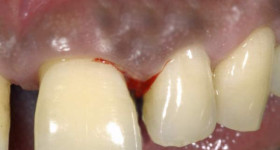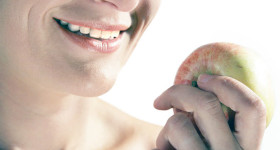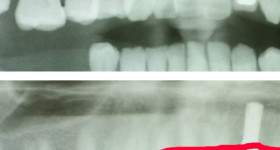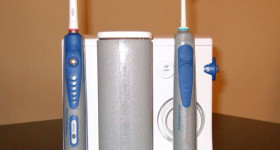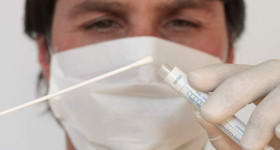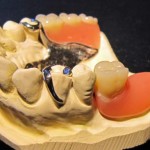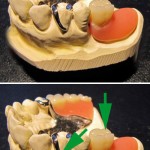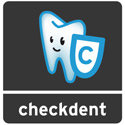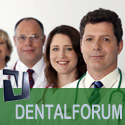Removable dentures, denture break, loss of abutment tooth, denture extension-these are the subjects we are talking about today-especially about dentures supported by mucous membrane!
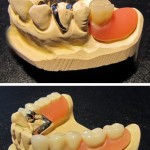 If masticatory forces are initiated on the mucous membrane it is called dentures supported by mucous membrane. You call it partial denture if there are teeth left. If there are no teeth left you call it full denture. Often teeth are used as fixation of partial dentures. You differentiate partial dentures with and without clasps (pic. 1).
If masticatory forces are initiated on the mucous membrane it is called dentures supported by mucous membrane. You call it partial denture if there are teeth left. If there are no teeth left you call it full denture. Often teeth are used as fixation of partial dentures. You differentiate partial dentures with and without clasps (pic. 1).
–
–
–
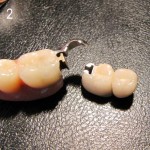 With partial dentures without clasps the clasp is substituted by different fixation elements (attachment, head abutment…)(pic.2) A part of fixation is integrated in the prosthesis; the tooth, which is used as the denture fixation, is crowned and this crown is used as the other fixation. That is why the term clasp tooth crown is often used and means crowned fixation tooth. Sometimes it is the aim with “partial dentures with clasps” to protect the fixation tooth from clasp and abrasion and so the tooth is randomly crowned, this is called clasp tooth crown as well. The advantage of partial dentures without clasps is the better aestetics, disadvantages are higher costs and the load of the tooth by the prosthesis. The more tighter the tooth is fixed with the prosthesis, the more higher is it´s load. If you chew, the mucous membrane is slipping, consequently the denture is moving (resilience), this movement is spread to the remaining tooth-the more tighter the fixation, the bigger the tooth dislocate. The remaining tooth can get lost after a few years!
With partial dentures without clasps the clasp is substituted by different fixation elements (attachment, head abutment…)(pic.2) A part of fixation is integrated in the prosthesis; the tooth, which is used as the denture fixation, is crowned and this crown is used as the other fixation. That is why the term clasp tooth crown is often used and means crowned fixation tooth. Sometimes it is the aim with “partial dentures with clasps” to protect the fixation tooth from clasp and abrasion and so the tooth is randomly crowned, this is called clasp tooth crown as well. The advantage of partial dentures without clasps is the better aestetics, disadvantages are higher costs and the load of the tooth by the prosthesis. The more tighter the tooth is fixed with the prosthesis, the more higher is it´s load. If you chew, the mucous membrane is slipping, consequently the denture is moving (resilience), this movement is spread to the remaining tooth-the more tighter the fixation, the bigger the tooth dislocate. The remaining tooth can get lost after a few years!
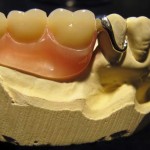 With classical partial dentures with clasps the load is lower, but not gone. Either way a partial denture is often the entering wedge to a full denture, cause normally the remaining teeth areslipping, a denture extension has to be made.
With classical partial dentures with clasps the load is lower, but not gone. Either way a partial denture is often the entering wedge to a full denture, cause normally the remaining teeth areslipping, a denture extension has to be made.
These process is often accelerate by false constructions of partial dentures. You see a so called free end situation in pic.3, there is no tooth behind the fifth tooth left and a partial denture with clasp was made.
–
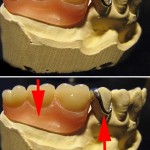 Position and direction of the clasp is wrong, cause the clasp is activated while chewing (pic.4)-i.e. the tooth is levered out-this should not happen. The clasp should not be activated until the denture is stick on the opposite dentition (pic 5 and 6), but it should be deactivated whilst chewing.
Position and direction of the clasp is wrong, cause the clasp is activated while chewing (pic.4)-i.e. the tooth is levered out-this should not happen. The clasp should not be activated until the denture is stick on the opposite dentition (pic 5 and 6), but it should be deactivated whilst chewing.
–
–
–
Whilst free end situation the clasp should be open backwards, as well as the lever should be constructed longer. The perfect construction would be, if the clasp along with the metallic end piece of the prosthesis (which rests on the chewing surface)is placed between the third and fourth tooth (longer lever and therefore less dislocation), as well as deactivation of the clasp whilst chewing and activation whilst removal the denture.
This would be the right way, although there would be less aesthetic and in addition this leads to break of dentures and/or break of clasp. That is why the clasps are designed wrong-the tooth is more strained, but this means the dentist/technician has no additional costs and the patient is happy for now-the aesthetic is also more advantageous.
–
–
–
–
–
–

